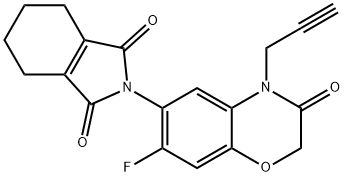Description
FLUMIOXAZIN is a benzoxazinones-type herbicide used on soybeans, peanuts, orchard fruits and other crop. It is a diphenyl ether group G herbicide that functioning through inhibiting the protoorphyrinogen oxidase. As a light-dependent peroxidising herbicide (LDPH), it takes effect by blocking heme and chlorophyll biosynthesis resulting in the accumulation of phototoxic porphyrins, leading to the membrane damage and further killing the weeds.
Definition
ChEBI: Flumioxazin is a benzoxazine that is N-(prop-2-yn-1-yl)-2H-1,4-benzoxazin-3(4H)-one which is substituted at position 6 by a 1,3-dioxo-1,3,4,5,6,7-hexahydro-2H-isoindol-2-yl group and at position 7 by a fluorine. A protoporphyrinogen oxidase inhibitor, it is used for the control of weeds in soya, peanuts, and a variety of vegetable and fruit crops. It has a role as a herbicide, an agrochemical, an EC 1.3.3.4 (protoporphyrinogen oxidase) inhibitor and a teratogenic agent. It is a benzoxazine, a terminal acetylenic compound, a dicarboximide and an organofluorine compound.
Metabolic pathway
When the rats are given a single oral dose of 14C-S-
53482, seven metabolites are identified in the urine
and the feces. Alcohol derivatives and the acetoanilide
derivative are isolated from the urine, and three
sulfonic acid conjugates with a sulfonic acid group
incorporated into the double bond of the 3,4,5,6-
tetrahydrophthalimide moiety are isolated from the
feces.





